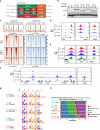Defining the relative and combined contribution of CTCF and CTCFL to genomic regulation
- PMID: 32393311
- PMCID: PMC7212617
- DOI: 10.1186/s13059-020-02024-0
Defining the relative and combined contribution of CTCF and CTCFL to genomic regulation
Erratum in
-
Author Correction: Defining the relative and combined contribution of CTCF and CTCFL to genomic regulation.Genome Biol. 2020 Jun 2;21(1):133. doi: 10.1186/s13059-020-02056-6. Genome Biol. 2020. PMID: 32487268 Free PMC article.
Abstract
Background: Ubiquitously expressed CTCF is involved in numerous cellular functions, such as organizing chromatin into TAD structures. In contrast, its paralog, CTCFL, is normally only present in the testis. However, it is also aberrantly expressed in many cancers. While it is known that shared and unique zinc finger sequences in CTCF and CTCFL enable CTCFL to bind competitively to a subset of CTCF binding sites as well as its own unique locations, the impact of CTCFL on chromosome organization and gene expression has not been comprehensively analyzed in the context of CTCF function. Using an inducible complementation system, we analyze the impact of expressing CTCFL and CTCF-CTCFL chimeric proteins in the presence or absence of endogenous CTCF to clarify the relative and combined contribution of CTCF and CTCFL to chromosome organization and transcription.
Results: We demonstrate that the N terminus of CTCF interacts with cohesin which explains the requirement for convergent CTCF binding sites in loop formation. By analyzing CTCF and CTCFL binding in tandem, we identify phenotypically distinct sites with respect to motifs, targeting to promoter/intronic intergenic regions and chromatin folding. Finally, we reveal that the N, C, and zinc finger terminal domains play unique roles in targeting each paralog to distinct binding sites to regulate transcription, chromatin looping, and insulation.
Conclusion: This study clarifies the unique and combined contribution of CTCF and CTCFL to chromosome organization and transcription, with direct implications for understanding how their co-expression deregulates transcription in cancer.
Keywords: 3D chromatin architecture; CTCF; CTCFL; Cancer; Chromatin insulation; Cohesin; Gene regulation; Loop extrusion.
Conflict of interest statement
The authors declare that they have no competing interests.
Figures







Similar articles
-
Interaction of CTCF and CTCFL in genome regulation through chromatin architecture during the spermatogenesis and carcinogenesis.PeerJ. 2024 Oct 15;12:e18240. doi: 10.7717/peerj.18240. eCollection 2024. PeerJ. 2024. PMID: 39430552 Free PMC article. Review.
-
CTCF and CTCFL in cancer.Curr Opin Genet Dev. 2020 Apr;61:44-52. doi: 10.1016/j.gde.2020.02.021. Epub 2020 Apr 22. Curr Opin Genet Dev. 2020. PMID: 32334335 Free PMC article. Review.
-
Choice of binding sites for CTCFL compared to CTCF is driven by chromatin and by sequence preference.Nucleic Acids Res. 2018 Aug 21;46(14):7097-7107. doi: 10.1093/nar/gky483. Nucleic Acids Res. 2018. PMID: 29860503 Free PMC article.
-
CTCF mediates chromatin looping via N-terminal domain-dependent cohesin retention.Proc Natl Acad Sci U S A. 2020 Jan 28;117(4):2020-2031. doi: 10.1073/pnas.1911708117. Epub 2020 Jan 14. Proc Natl Acad Sci U S A. 2020. PMID: 31937660 Free PMC article.
-
Discovering a binary CTCF code with a little help from BORIS.Nucleus. 2018 Jan 1;9(1):33-41. doi: 10.1080/19491034.2017.1394536. Epub 2017 Dec 5. Nucleus. 2018. PMID: 29077515 Free PMC article. Review.
Cited by
-
Author Correction: Defining the relative and combined contribution of CTCF and CTCFL to genomic regulation.Genome Biol. 2020 Jun 2;21(1):133. doi: 10.1186/s13059-020-02056-6. Genome Biol. 2020. PMID: 32487268 Free PMC article.
-
Comprehensive Transcriptome Analysis Expands lncRNA Functional Profiles in Breast Cancer.Int J Mol Sci. 2024 Aug 2;25(15):8456. doi: 10.3390/ijms25158456. Int J Mol Sci. 2024. PMID: 39126025 Free PMC article.
-
The combined action of CTCF and its testis-specific paralog BORIS is essential for spermatogenesis.Nat Commun. 2021 Jun 22;12(1):3846. doi: 10.1038/s41467-021-24140-6. Nat Commun. 2021. PMID: 34158481 Free PMC article.
-
A negatively charged region within carboxy-terminal domain maintains proper CTCF DNA binding.iScience. 2024 Nov 22;27(12):111452. doi: 10.1016/j.isci.2024.111452. eCollection 2024 Dec 20. iScience. 2024. PMID: 39720519 Free PMC article.
-
Regulatory architecture of housekeeping genes is driven by promoter assemblies.Cell Rep. 2023 May 30;42(5):112505. doi: 10.1016/j.celrep.2023.112505. Epub 2023 May 12. Cell Rep. 2023. PMID: 37182209 Free PMC article.
References
-
- Sanborn AL, Rao SS, Huang SC, Durand NC, Huntley MH, Jewett AI, Bochkov ID, Chinnappan D, Cutkosky A, Li J, et al. Chromatin extrusion explains key features of loop and domain formation in wild-type and engineered genomes. Proc Natl Acad Sci U S A. 2015;112:E6456–E6465. doi: 10.1073/pnas.1518552112. - DOI - PMC - PubMed

